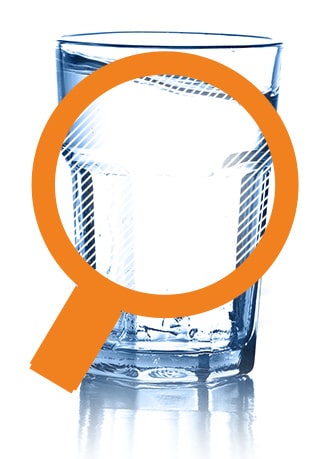Dear ,
This is your TEST ASSURED Report
BASED ON LABORATORY TESTING AND ANALYSIS YOUR TAP SCORE IS (BAD)
Order May 15, 2019


Understanding your Tap Score
SimpleWater’s health risks analysis compares your sample’s contaminant levels to the latest publicly available toxicological and epidemiological research. This is done in order to give you a clear idea of what potential risks may be in your water. Click on each contaminant to learn more about its known health impacts and potential sources. This analysis should not be taken as professional health advice.
-
GOOD - You're In The Clear
If your result is to the left of the middle line it means we detected this contaminant but at a concentration that is not known to cause health problems for healthy adults.
-
ELEVATED - Approximate Risk Factor < 1 in 100,000
Drinking water contaminated at this level is not immediately concerning but is worthwhile monitoring since concentrations may vary over time and there may be a small long term health risk.
-
MODERATE - Approximate Risk Factor > 1 in 100,000
Drinking water contaminated at this level over several years is thought to pose a moderate health risk. If you drink this water frequently it's worth considering treatment.
-
HIGH - Approximate Risk Factor > 1 in 10,000
Drinking water contaminated at this level over several years is thought to pose a significant health risk that should not be ignored. We do not recommend drinking this water without treatment.
-
VERY HIGH - Approximate Risk Factor > 1 in 1,000
Drinking water water contaminated at this level is thought to pose a high risk to your health. If possible, other water sources should be used or appropriate water treatment should be installed.

We use the following measurement units:
- Parts Per Million (PPM)
Equals 1 milligram per Liter - Parts Per Billion (PPB)
Equals 1 microgram per Liter
General properties of your water
The following section describes general indicators of your overall water quality. These parameters may not directly impact your health but they will influence the chemical nature of metals and other potential contaminants in your water supply.
-
pH
Normal
A measure of your water's acidity / basicity. In water with a low pH you may experience a bitter metallic taste and see corrosion. In water at high pH you may experience "slippery" water with a soda taste and find deposits on your fixtures.
-
ALKALINITY
Normal
Determined by the properties of minerals dissolved in your water. It's a measure of your water's capacity to resist changes to pH. Strongly alkaline water has an objectionable taste which resembles baking soda.
-
HARDNESS
Normal
A measure of your water's acidity / basicity. In water with a low pH you may experience a bitter metallic taste and see corrosion. In water at high pH you may experience "slippery" water with a soda taste and find deposits on your fixtures.
-
IRON LEVEL
Normal
Mostly representative of the calcium and magnesium in your water. Hard water may cause an unpleasant taste in your water and is known to leave residues on water fixtures, be harmful to your pipes and make it difficult to form bubbles when using soaps.
-
IRON LEVEL
Normal
At moderate concentrations iron will give water an unpleasant metallic taste. Less than 1 PPM of iron may cause reddish brown stains on your water fixtures and clothing.
-
Chlorine Levels
Normal
Chlorine is a chemical element with the symbol Cl and atomic number 17. The second-lightest of the halogens, it appears between fluorine and bromine in the periodic table and its properties are mostly intermediate between them. Chlorine is a yellow-green gas at room temperature.
-
COLOR
Detected
The color of water varies with the ambient conditions in which that water is present. While relatively small quantities of water appear to be colorless, pure water has a slight blue color that becomes a deeper blue as the thickness of the observed sample increases.
-
ODOR
Detected
Sometimes you may notice your water tastes or smells different to usual. This could be down to a number of reasons. Water contains a number of naturally occurring elements and minerals
Watch list
HERE ARE THE GREATEST POTENTIAL HEALTH RISKS IN YOUR DRINKING WATER.
At the end of your Tap Score report you’ll find an exhaustive list of the contaminants tested in your sample and their position relative to these goals. As we continue to research water contamination and health we will update your score accordingly.
Other findings
THESE ARE THE CONTAMINANTS WE DETECTED BELOW POTENTIALLY DANGEROUS LEVELS.
-
MERCURY show more
YOUR MEASUREMENT
0.001 PPMHEALTH EFFECTS
Chronic mercury ingestion above the US EPA limit of 2 PPB can cause kidney damage. Methyl mercury in particular may be a dangerous neurotoxin, affecting vision, hearing and memory.COMMON SOURCES
Primary sources of mercury in drinking water are coal-fired power plants, medical and municipal waste incinerators, metal and cement manufacturing, crop runoff, and erosion of natural deposits.
-
NICKEL show more
YOUR MEASUREMENT
0.001 PPMHEALTH EFFECTS
Nickel can be a potent human carcinogen at high doses, in lower doses it can lead to decreased lung function and allergic reaction. About 10-20% of the US population is sensitive to nickel.COMMON SOURCES
Nickel is a naturally occurring element found commonly in earth's bedrock as well as in the waste water from mining and smelting activities.TASTE & ODOR
Nickle compounds have no characteristic odor or taste
-
SODIUM show more
YOUR MEASUREMENT
0.001 PPMHEALTH EFFECTS
High sodium levels can lead to increased blood pressure and hypertension but sodium is not often found at toxic levels in drinking water.
COMMON SOURCES
Sodium is commonly detected and tasted in drinking water. Saline intrusion, mineral deposits, seawater spray, sewage effluents, and road salts used in de-icing can all contribute significantly to sodium levels in drinking water. In addition, water-treatment chemicals and water softeners can cause high sodium levels at the tap.
TASTE & ODOR
Sodium produces a salty taste in drinking water which can be detected (depending on someone's age) between 30 to 460 ppm.
-
MAGNESIUM show more
YOUR MEASUREMENT
0.001 PPMHEALTH EFFECTS
There are no known direct human health impacts from magnesium in your water.
COMMON SOURCES
Magnesium is a key component of water hardness and is found naturally occurring in many rocks and minerals. Erosion eventually washes it into water sources. Sudden increases in magnesium levels could be due to increased oil and gas activity nearby a well.
TASTE & ODOR
While magnesium can make your water taste better, too much of it can contribute to hard water and form scale in your pipes.
-
ALKALINITY (AS CACO3) show more
YOUR MEASUREMENT
0.001 PPMDetermined by the properties of minerals dissolved in your water. It's a measure of your water's capacity to resist changes to pH. Strongly alkaline water has an objectionable taste which resembles baking soda.
-
FLUORIDE show more
YOUR MEASUREMENT
0.001 PPMHigh levels of fluoride in drinking water can cause bone disease and dental fluorosis.COMMON SOURCES
Fluoride in drinking water is commonly eroded from natural deposits; used as a fertilizer, used in aluminum industries and also commonly added to public drinking water as an additive to protect teeth.
-
TOTAL DISSOLVED SOLIDS show more
YOUR MEASUREMENT
0.001 PPMHEALTH EFFECTS
Since TDS is a general characteristic of water and does not itself have known health effects, however the particulate materials which cause high TDS and can themselves be harmful to human healthCOMMON SOURCES
As water travels over the land surface and through the ground, it dissolves naturally occurring minerals. TDS is a measure of all those dissolved particles in your water. It is a general characteristic of water rather than a specific chemical.TASTE & ODOR
Water containing high TDS will often smells bad and taste bitter, salty or metallic
-
NITRATE (AS N) show more
YOUR MEASUREMENT
0.001 PPMHEALTH EFFECTS
Methemoglobinemia, "blue baby" syndrome is a severe risk when nitrate levels exceed 10 PPM and an infant or pregnant woman is exposed to such water.
COMMON SOURCES
Nitrogen is an essential nutrient for plants and is commonly used for agricultural and lawncare purposes. Nitrates (and Nitrites) most often enter your drinking water from runoff due to animal waste, fertilizer, natural deposits, septic tank leakage and sewage. Nitrites will rapidly transform into Nitrates.
-
BARIUM show more
YOUR MEASUREMENT
0.001 PPMHEALTH EFFECTS
Long term exposure to barium in drinking water can cause an increase in blood pressure and ultimately damage the cardiovascular system.COMMON SOURCES
Barium is natural present in soil and earth and is also used by industry, including: oil drilling muds, paper manufacture, soap, rubber, linoleum, dyes, pyrotechnics, metallurgy, and ceramics.
-
SULFATE show more
YOUR MEASUREMENT
0.001 PPMHEALTH EFFECTS
High levels of sulfate (above 250 ppm) may have a laxative effect and cause dehydration, especially among infants.
COMMON SOURCES
Sulfate most often enters drinking water when it comes in contact with underground rock formations and waste streams from nearby industrial activity.
TASTE & ODOR
Salty Taste, laxative effect
